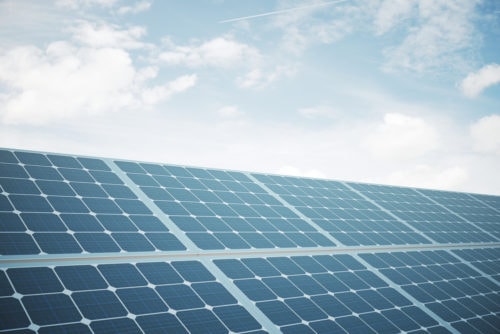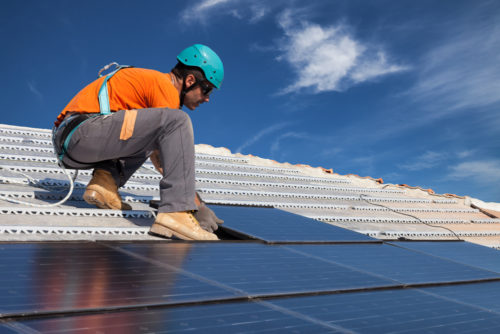What Are Solar Panels Made Of?
Page Contents
Written by qualified solar engineer Leonardo. Last updated:
Most solar panels are manufactured from silicon. Depending on how silicon is processed, it can be monocrystalline, polycrystalline, or amorphous. Crystalline panels are the most common, while amorphous silicon panels are part of the “thin-film” category, which is used less.
Solar panels generate electricity without moving or producing noise, making them an excellent renewable energy source for buildings. Nobody is exposed to heavy machinery in movement, and the distracting effect of noise is prevented. With these unique features, one of the first questions asked by home or building owners is: “what are solar panels made of?”.
All monocrystalline and polycrystalline panels are made from silicon, but thin-film panels can be produced with other substances. The materials used in solar roofs of the thin-film type include cadmium telluride (CdTe) and copper indium gallium diselenide (CIGS).
Processing Silicon into Solar Cells
By itself, pure silicon does not produce electricity under sunlight. However, other elements can be added in small amounts to achieve this effect. Adding phosphorus produces a surplus of electrons to carry electricity, and the result is N-type silicon. On the other hand, the addition of boron or gallium causes an electron deficit, and the product is called P-type silicon. When both types of silicon are arranged in layers, light induces an electron movement between them, producing an electric power output.
Pure silicon is not found in nature, and instead it must be obtained from silicon dioxide, which contains impurities. Silicon dioxide is melted, and unwanted elements are removed with physical and chemical processes. Once the silicon has been purified, it is converted into N-type or P-type silicon by adding other elements in controlled amounts.
Amorphous silicon is the type used in some thin-film panels, and it gets its name because the molecular structure is not crystalline.
How to Identify the Different Types of Solar Panels
The language used when describing the types of solar panels may sound very technical. However, the three main types can be easily identified based on their appearance.
If a panel has a grid-like surface that is separated into solar cells, it belongs to one of the crystalline types. Monocrystalline panels use only one silicon crystal per cell, and they are characterized by their black color. On the other hand, polycrystalline cells are made of multiple crystals, and they have a lighter blue tone. Solar cells are produced from molten silicon in both cases. However, monocrystalline cells demand more process control to ensure they are made from a single crystal.

Identifying thin-film panels is even easier, since they have a uniform surface without divisions. This is due to their manufacturing process, where the solar material is deposited in layers rather than individual cells.
Before choosing between the solar panel types, the first step is understanding how they work. Consider that electricity is only produced when sunlight is available, and the maximum production is only achieved around noon. If you want to use solar energy 24/7, you must add battery storage for the night or cloudy days.
Comparing the Types of Solar Panels: Advantages and Disadvantages
The different types of solar panels have pros and cons, like in most other decisions that deal with technology.
- Monocrystalline panels are the most efficient, which means the production of electricity per square foot is higher. Therefore, these panels are the best option if you have limited space for the solar energy system. However, monocrystalline panels are also the most expensive, since they are the most difficult to produce.
- Polycrystalline panels have a moderate efficiency, but they are also more affordable than monocrystalline panels. They are also the most common type.
- Thin-film solar panels have the lowest cost and weight. However, they are also the least efficient panels, having the lowest electricity production per square foot. In other words, thin-film panels need more space than crystalline panels to reach a specified capacity. All three types of solar panels lose performance when they heat up, but thin-film panels suffer less from this effect.
The costs associated with installation are similar for all types of solar panels. Thin-film panels are easier to handle thanks to their low weight, but you also need to install more of them. Polycrystalline and monocrystalline panels are similar in terms of weight and size.
The appearance of solar panels is a subjective factor, but it can also influence purchasing decisions. While some users may like the smooth surface of thin-film panels, other may prefer the traditional appearance of crystalline panels. All three types of solar panels achieve good results when installed by a qualified company. However, if you prefer thin-film panels, make sure you have the roof space to accommodate a larger installation.

The solar panel buying information provided by manufacturers contains many details about the panel type and efficiency. Solar installers use these technical specifications to select the best option for your property.
Additional Materials Needed to Produce Solar Panels
Silicon solar cells are the core of solar panels, but other materials are needed to allow their use in outdoor settings. Solar cells are protected by a housing, which is normally produced from aluminum or fiberglass. Also, the side of solar cells that faces the sun is covered by glass, so sunlight can reach them. Most commercial solar panels use either 60 or 72 cells per unit.
Solar panels also have internal wiring, since the solar cells must be connected together to gather their electricity production. The connection terminals of a solar panel are really the ends of a circuit that connects all the cells inside.
It is important to note that solar panel manufacturing methods have evolved over time. At first, solar power was regarded as a technology for satellites and other outer space applications. Therefore, manufacturers focused on lightweight designs. When solar power became a viable electricity source for homes and businesses, panel designs became more robust and durable.
We hope you liked this article. Please rate it or leave us a comment.
Average rating 4.5 / 5. Vote count: 13
No votes so far! Be the first to rate this post.
References
- Solar Photovoltaic cell Basics – Department of Energy
- Photovoltaics – SEIA





